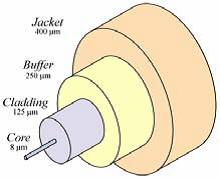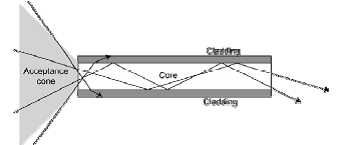- Related articles
- All Cisco QSFP-40G-SR-BD’s Information ( Overview, Features, Datasheet PDF, Price, Specifi
- What is a BiDi transceiver?
- All Cisco GLC-BX40-U-I's information (List price, Specs, Datasheet PDF, Compatibility matr
- Optical Transceivers for Cisco IE-3010-24TC Switch
- Optical Transceivers for Cisco C6800-16P10G-XL= Switch
- Optical Transceivers for Cisco SM-D-ES3G-48-P= Switch
- All Cisco SFP-OC48-IR1's information (List price, Specs, Datasheet PDF, Compatibility matr
- Optical Transceivers for Cisco SG300-10PP-K9EU-RF Switch
- What Is ADSS Optical Fiber Cable?
- What is Overhead Fiber Optic Cable?
Recommend tag

What are modes in optical fiber?
Definition
An optical fiber (or optical fibre) is a flexible, transparent fiber made by drawing glass (silica) or plastic to a diameter slightly thicker than that of a human hair.Optical fibers are used most often as a means to transmit light between the two ends of the fiber and find wide usage in fiber-optic communications, where they permit transmission over longer distances and at higher bandwidths (data rates) than wire cables.
Applications
Optical fiber is used by many telecommunications companies to transmit telephone signals, Internet communication, and cable television signals. Due to much lower attenuation and interference, optical fiber has large advantages over existing copper wire in long-distance and high-demand applications.
Number of modes in optical fiber
The mode theory, along with the ray theory, is used to describe the propagation of light along an optical fiber. The mode theory uses electromagnetic wave behavior to describe the propagation of light along a fiber. The optical wave is effectively confined within the guide and the electric field distribution in the x-direction does not change as the wave propagates in the z direction. The stable field distribution in the x direction with only a periodic z dependence is known as a mode. A specific mode is obtained only when the angle between the propagation vectors or the rays and the interface has a particular value. Hence, the light propagating within the guide is formed into discrete modes, each typified by a distinct value of θ.
Single Mode Fibers
Fiber supporting only one mode is called single-mode or mono-mode fiber. Single-mode fiber allows for a higher capacity to transmit information because it can retain the fidelity of each light pulse over longer distances, and it exhibits no dispersion caused by multiple modes. The most common type of single-mode fiber has a core diameter of 8 to 10 μm. The smaller core diameter makes coupling light into the core more difficult. Data rates of up to 10 gigabits per second are possible at distances of over 60 km with commercially available transceivers.
Multi-mode Fiber
Multimode fiber is best designed for short transmission distances and is suited for use in LAN systems and video surveillance. Modes result from the fact that light will only propagate in the fiber core at discrete angles within the cone of acceptance. Multi-mode fibers have large core diameters and they can support applications from 10 Mbit/s to 10 Gbit/s over link lengths of up to 550 meters, more than sufficient for the majority of premises applications.
Optical Fiber Configurations
Measurements are made for a number of dual fiber optic configurations to determine their relative sensitivity using bare fibers and graded-refractive-index lenses.
Conclusion
Fiber optic transmission has found a vast array of applications in computer systems. Some design considerations depend largely on the application. For certain terminal to terminal application, crucial factors including maximizing transmission speed and distance and minimizing fiber and splice loss. By contrast, connector loss becomes important in local area networks that operate within buildings. In other systems, it is important to minimize the cost of cable, with the intention of reducing the cost of terminal equipment. These system considerations make design and construction of practical fiber optic systems a difficult task. Guidelines appropriate for one system is usually not suitable for another system.

TECHNICAL SUPPORT
Get solutions or consultation from the technical team.






















































